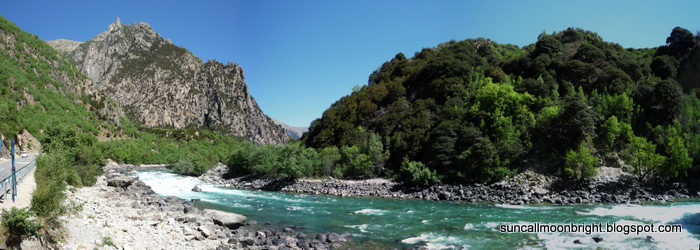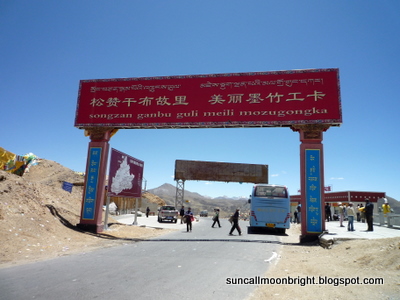View the previous post here or return to the trip index here.
02 Jun 2009
Today we embarked on the longest bus ride of the entire journey from Bayi Town in Nyingchi to Lhasa. En route, there were many sights as the greenery in Nyingchi recedes, giving way to barren rocks. Most challenging of all, our bus ride will take us across the Mi La Mountain Pass (米拉山口, mi la shan kou) at an altitude of 5013.25 metres. But not before we enjoyed a low oxygen lunch at 4500 metres -- the most tiring meal of the trip. Interestingly, the highway we were on links all the way from Shanghai to Nepal. The Sichuan to Lhasa section was built by the People's Liberation Army at a hefty cost of one to two lives per kilometre due to the harsh nature of a low oxygen environment.

A quick stop along the way to buy the excellent watermelons in Nyingchi. This will be the last time we have them.

Toilet break

We came to Ah Pei's New Village (阿沛新村, ah pei xin cun). It seems that Ah Pei was the Tibetan general (or noble man) that went to Beijing to negotiate the Chinese liberation of Tibet. As a result his kin were awarded a new village that's kept spick and span. They even have a cool bus stop.

An old Tibetan couple spinning Manni Wheels

This village in the middle of nowhere has streets so neat it puts some cities to shame.

Most Tibetan towns around here have homes built in this design

This looks like an important building. Inside houses a small exhibition containing old artifacts of the previous people that lived here.

After leaving the village, we came to a scenic photo spot where a large rock blocks the flow of the Yarlung Tsangpo River. On the large rock were some white khatas possibly thrown over

More of the blue river

The look out point were the picture of the rock was taken.

Beyond the rock and panorama of the river


Over on the other side of the road were toilets, souvenir stalls, and here, a dried fruit stall

Continuing along the river, we came to view an old town on the opposite bank that was an important stop for travellers in the old days

Panorama of the old town. A White Stupa is indicative of a storage place for scripture.


Next, we came up to our lunch stop at 4500 metres! Some of our fellow tour members were already sniffing from the oxygen canisters.

It's Sichuan cuisine as usual

This is one of the best meals we had with the most amazing dish being the herbal chicken soup. Piping hot on a cool afternoon. We took our time to chew through the meal as there's only approximately 60% of oxygen at sea level over here. Rice is actually cooked using pressure cookers.


Finally, we arrived at Mi La Mountain Pass, some 5012.25 metres above see level and we saw two cyclist that cycled all the way up here from Chengdu!

The winds were strong. Streamers made from colourful flags are a common sight in Tibet. Mantras are written on them such that when the wind blows, the mantra is "recited". Blue signifies the sky, White, clouds, Red, fire, Green, nature, and Yellow, river.

The view from the top is beautiful, but it seems like global warming has taken its toll. According to my uncle whose been to Tibet seven times, there used to be snow here.

Panorama from Mi La Mountain Pass


Crossing the mountain pass, we were in the Lhasa district where the land is mostly barren and trees are scarce due to the punishing sun. Here, heaps of yak dung are dried in the sun by yak herding tribes to be used as burning material. I wonder if they use it as fuel for cooking...

Yak skin tents belonging to the Tibetan tribe that herds in these areas. My guide claims that they are actually very well off although they live in such tents. I have noticed some shiny new looking motorcycles parked outside a few of them.

A Tibetan pilgrim en route to Lhasa. The do not just walk there, they have to prostrate themselves fully on the ground at every step from the start of their village until they arrive in Lhasa. Everyone should do this once in a lifetime and it is usually organised by the villages that will send an accompanying vehicle carrying rations. They rest by nightfall and the pilgrimage can take up to two years or more for those that live further from Lhasa.

Panorama at another pit stop


Some wild flowers

Then, we arrived at the birthplace of Songtsän Gampo, the famous founder of the first Tibetan Empire and had famously married a princess each from Nepal and the Tang Dynasty.

Opposite the tablet is the entrance to the birthplace

However we would not be visiting as we were only making a pit stop

The sun's strong rays here are commonly harnessed to heat water
After a short break, we were headed towards our next highlight before reaching Lhasa city proper. This was Ganden Monastery, the founding lamasery of the prevalent Yellow Hat Sect built near the top of a mountain. Also, it was one of the only lamaseries that allowed the taking of pictures within it for a fee (donation).
View the next related post here. Return to the trip index here.
View the next related post here. Return to the trip index here.
No comments:
Post a Comment